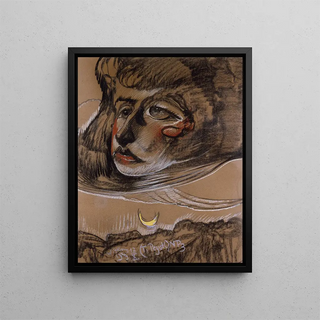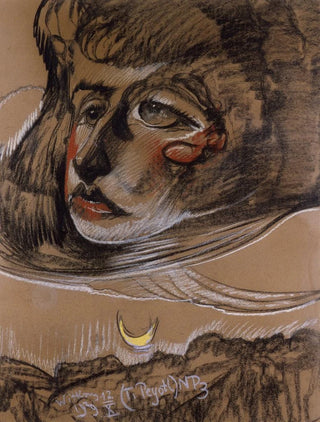Art print | Portrait of Nena Stachurska - Stanisław Ignacy Witkiewicz


View from behind

Frame (optional)
Portrait of Nena Stachurska - Stanisław Ignacy Witkiewicz – Captivating Introduction
The "Portrait of Nena Stachurska" by Stanisław Ignacy Witkiewicz is a work that transcends the simple frame of painting to become a true window into the human soul. In this painting, the Polish artist, known for his innovative approach and psychological sensitivity, captures the essence of a young woman whose gaze seems to tell a multitude of stories. The composition, both intimate and revealing, invites the viewer to immerse themselves in a universe where every detail is loaded with meaning. The light, colors, and expressions combine to create an atmosphere that is both mysterious and captivating, making this work a must-see from the early 20th century.
Style and uniqueness of the work
Witkiewicz's style is distinguished by its bold blend of realism and expressionism. In the "Portrait of Nena Stachurska," the artist uses energetic brushstrokes and vibrant colors that breathe palpable life into the subject. Nena's facial features are both delicate and assertive, demonstrating Witkiewicz's technical mastery. His psychological approach goes beyond mere physical representation; he manages to capture an emotion, a thought, an essence. This portrait does not merely depict a person; it evokes an atmosphere, a period. Each glance at this work reveals a new facet of Nena's personality, making the experience of observation always renewed.
The artist and his influence
Stanisław Ignacy Witkiewicz, often called Witkacy, is an emblematic figure of Polish modern art. His eclectic training and interest in philosophy, psychology, and literature allowed him to develop a unique vision of art. Witkiewicz was not limited to painting; he was also a playwright and writer, which enriched his artistic approach. His influence is felt not only within the Polish artistic community but also internationally. By integrating elements of Polish culture while drawing inspiration from European avant-garde movements, he managed to create a distinctive style that continues to inspire

Matte finish

View from behind

Frame (optional)
Portrait of Nena Stachurska - Stanisław Ignacy Witkiewicz – Captivating Introduction
The "Portrait of Nena Stachurska" by Stanisław Ignacy Witkiewicz is a work that transcends the simple frame of painting to become a true window into the human soul. In this painting, the Polish artist, known for his innovative approach and psychological sensitivity, captures the essence of a young woman whose gaze seems to tell a multitude of stories. The composition, both intimate and revealing, invites the viewer to immerse themselves in a universe where every detail is loaded with meaning. The light, colors, and expressions combine to create an atmosphere that is both mysterious and captivating, making this work a must-see from the early 20th century.
Style and uniqueness of the work
Witkiewicz's style is distinguished by its bold blend of realism and expressionism. In the "Portrait of Nena Stachurska," the artist uses energetic brushstrokes and vibrant colors that breathe palpable life into the subject. Nena's facial features are both delicate and assertive, demonstrating Witkiewicz's technical mastery. His psychological approach goes beyond mere physical representation; he manages to capture an emotion, a thought, an essence. This portrait does not merely depict a person; it evokes an atmosphere, a period. Each glance at this work reveals a new facet of Nena's personality, making the experience of observation always renewed.
The artist and his influence
Stanisław Ignacy Witkiewicz, often called Witkacy, is an emblematic figure of Polish modern art. His eclectic training and interest in philosophy, psychology, and literature allowed him to develop a unique vision of art. Witkiewicz was not limited to painting; he was also a playwright and writer, which enriched his artistic approach. His influence is felt not only within the Polish artistic community but also internationally. By integrating elements of Polish culture while drawing inspiration from European avant-garde movements, he managed to create a distinctive style that continues to inspire






